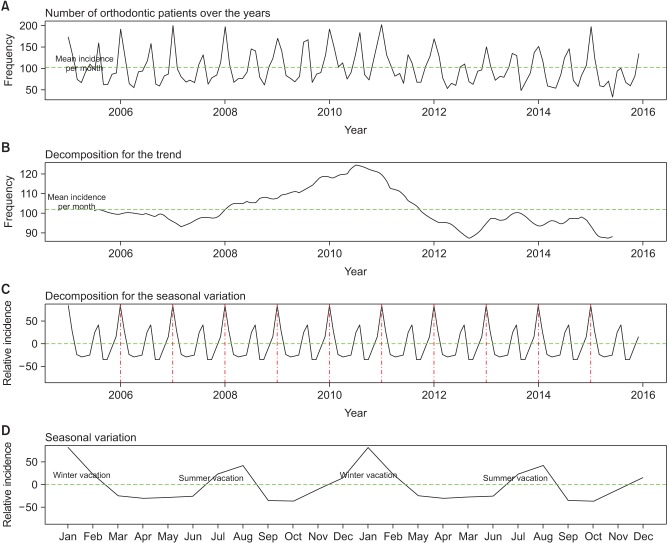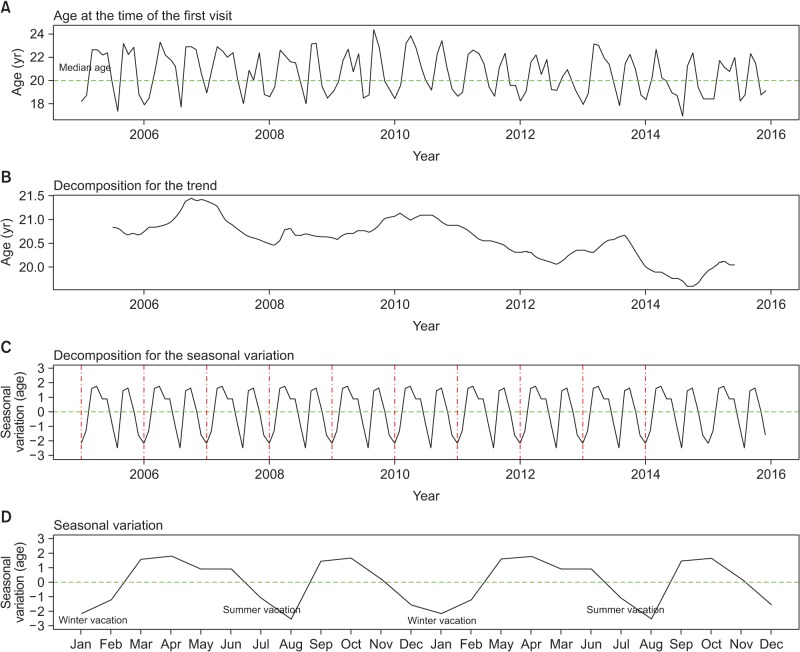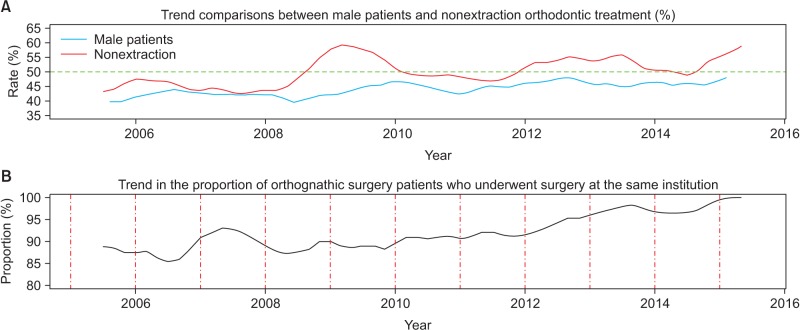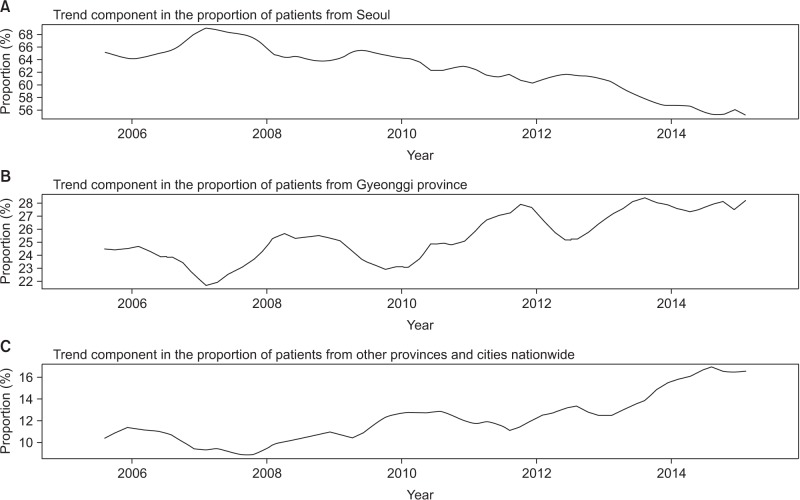Abstract
Objective
This paper describes changes in the characteristics of patients seeking orthodontic treatment over the past decade and the treatment they received, to identify any seasonal variations or trends.
Methods
This single-center retrospective cohort study included all patients who presented to Seoul National University Dental Hospital for orthodontic diagnosis and treatment between January 1, 2005 and December 31, 2015. The study analyzed a set of heterogeneous variables grouped into the following categories: demographic (age, gender, and address), clinical (Angle Classification, anomaly, mode of orthodontic treatment, removable appliances for Phase 1 treatment, fixed appliances for Phase 2 treatment, orthognathic surgery, extraction, mini-plate, mini-implant, and patient transfer) and time-related variables (date of first visit and orthodontic treatment time). Time series analysis was applied to each variable.
Results
The sample included 14,510 patients with a median age of 19.5 years. The number of patients and their ages demonstrated a clear seasonal variation, which peaked in the summer and winter. Increasing trends were observed for the proportion of male patients, use of non-extraction treatment modality, use of ceramic brackets, patients from provinces outside the Seoul region at large, patients transferred from private practitioners, and patients who underwent orthognathic surgery performed by university surgeons. Decreasing trends included the use of metal brackets and orthodontic treatment time.
Conclusions
Time series analysis revealed a seasonal variation in some characteristics, and several variables showed changing trends over the past decade.
Keywords: Time series analysis, Orthodontics, Trend, Seasonal variation
INTRODUCTION
Orthodontic treatment is the treatment of choice for the correction of malocclusions and improvement of facial esthetics. With socio-economic development, orthodontic treatment has become a common clinical procedure.1 In addition, significant improvements have been made in orthodontic biomechanics, techniques, and appliances. In this respect, in the United States and in Europe, frequent nationwide surveys have helped us understand the changing trends in the characteristics of patients seeking orthodontic treatment and in the orthodontic treatment procedures they receive.2,3,4,5,6
However, formal reports on the changing trends in orthodontics seem insufficient.7,8,9 Graphic representation of time-related variables may help us understand the changes in these trends. Time series analysis is a popular method for describing changes over time. However, as of May 2017, an internet search of PubMed and Web of Science revealed only one paper that applied the time series analysis method to orthodontics.10 Time series analysis is a sophisticated statistical method that can reveal greater information than a cursory observation of data. The substantial advantage of time series analysis is the decomposition that eliminates noise and amplifies the signal within the time series data. Decomposing a time series separates the data into a trend component and a seasonal component, if one exists.10,11,12,13
The purpose of this study was to determine whether the trends in orthodontic treatment have changed over the past decade (from 2005 to 2015) among all the patients seeking orthodontic treatment at Seoul National University Dental Hospital. The specific aim of this study was to identify any seasonal variations or trends by using a time series analysis.
MATERIALS AND METHODS
Study design and sample
The study population of this single-center retrospective cohort study comprised all the patients who presented to the Department of Orthodontics at Seoul National University Dental Hospital for orthodontic diagnosis and treatment from January 1, 2005 to December 31, 2015. Patients who had only a simple consultation and did not undergo any diagnostic studies (i.e., radiographic, photographic, and dental cast examination) were excluded. The institutional review board of Seoul National University School of Dentistry for the protection of human subjects reviewed and approved the research protocol (number S-D 20140025).
Study variables (Table 1)
Table 1. Summary of patients seeking orthodontic treatment from January 2005 to December 2015.
Values are presented as number (%) or median ± interquartile range.
*Proportion calculated among patients who had undergone Phase 2 treatment.
The data collected from each patient's record included a set of heterogeneous variables that could be categorized as follows.
1) Demographic variables
Age, gender, and address
2) Clinical variables
Angle Classification
Anomaly
Mode of orthodontic treatment: Phase 1, Phase 2, or both
Removable appliances for Phase 1 treatment: headgear, chin-cap, facemask, or bionator
Fixed appliances for Phase 2 treatment: metal, ceramic, lingual, or aligner appliances
Orthognathic surgery (yes/no) and the place where the surgery was performed (at the same institution or in a private practice)
Extraction treatment modality (yes/no)
Mini-plate (yes/no)
Mini-implant (yes/no)
Patients treated by residents or by faculty members
Patients transferred from a private office (yes/no)
3) Time-related variables
Date on which orthodontic treatment commenced and orthodontic treatment time. Treatment time was defined as the time elapsed from the placement of the first active orthodontic component to the day of debonding/debanding.
Statistical analysis
Descriptive statistics were computed for each variable. For age- and time-related variables, the median rather than the mean was calculated because the median is less influenced by extreme values.2,10 The R programming language (R Foundation for Statistical Computing, Vienna, Austria) was used for the time series analysis.13
RESULTS
Review of all the patients who underwent orthodontic treatment
A total of 14,510 patients were evaluated (median age, 19.5 years), and 41.6% were male, who were slightly younger than the female patients. Class III malocclusion was present in 40% of the patients reviewed, followed by Class II (32.3%) and Class I (27.5%) malocclusions. After the initial diagnosis and consultation, more than half of the patients (53.0%) received no further orthodontic treatment (Table 1).
Patients who underwent active orthodontic treatment
Among the patients who underwent orthodontic treatment, 30.7% underwent orthognathic surgery; 44.6% underwent orthodontic treatment with extraction and 13.7% with mini-implants or mini-plates; 25.3% were treated by faculty members and 74.7% by residents; and 8% had been transferred from private practitioners. The median duration of orthodontic treatment was 1 year 6 months in non-extraction cases and 2 years 2 months in cases that involved extraction.
Results of the time series analysis and variables that demonstrated a seasonal variation or trend
Number of patients seeking orthodontic treatment
The trend did not show a clear pattern. However, a clear seasonal variation was found that included peaks every winter and summer (Figure 1).
Figure 1. A, The number of patients seeking orthodontic treatment. B, The trend component. C, Seasonal variation. D, A magnified view of the seasonal variation demonstrates peaks during each winter and summer.
Patient ages
A slightly decreasing trend was observed in the median age of patients over time. In addition, age showed a distinct seasonal variation in a pattern opposite to that of the number of patients (Figure 2).
Figure 2. A, The patients' median age is 19.5 years. B, Time series analysis shows a slightly decreasing trend in median age over time. C, Seasonal variation. D, A large-scale view of seasonal variation.
Other variables that demonstrated a changing trend over the past decade
The proportions of male patients and non-extraction treatment modality showed increasing trends (Figure 3A), while the percentage of patients who underwent orthognathic surgery at the same institution also increased (Figure 3B). The proportion of patients whose addresses were in Seoul decreased over the decade, and that of patients from Gyeonggi or other provinces increased (Figure 4). For active orthodontic treatment, the use of ceramic brackets increased over the years, while the proportion of metal brackets decreased (generalized linear model analysis, p < 0.0001, Figure 5).
Figure 3. A, The proportion of male patients and of non-extraction treatment. B, The percentage of patients who underwent orthognathic surgery at the same institution.
Figure 4. The proportion of patients whose address was in Seoul and from Gyeonggi or other provinces.
Figure 5. Appliances used for Phase 2 treatment.
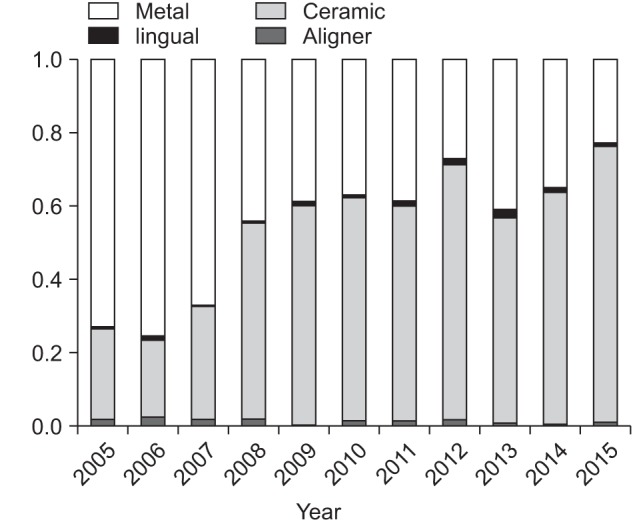
Orthodontic treatment time varied significantly among patients (Figure 6). Treatment with extraction took 8 months longer than did treatment without extraction (linear model analysis, p = 0.0053). The median time for orthodontic treatment decreased by an average of 2 months per year (p < 0.0001). The proportion of patients who underwent orthognathic surgery performed by surgeons at the same institution showed an increasing trend (time-series graph not shown). The number of patients who were transferred from private practitioners also increased (time-series graph not shown).
Figure 6. Orthodontic treatment time.
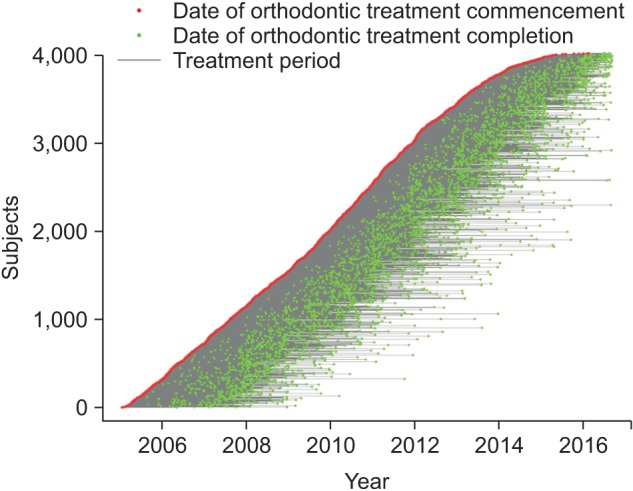
DISCUSSION
The purpose of this study was to determine whether trends in orthodontic treatment changed over the decade from 2005 to 2015 among all the patients seeking orthodontic treatment at Seoul National University Dental Hospital. The specific aim of this study was to identify any seasonal variations and/or trends by using a time series analysis.
To the authors' knowledge, this is the first study to examine the current trends in orthodontic management by using a time series analysis. As expected, a seasonal variation was evident in the number of patients and their ages. The heights of the peaks coincided with the summer and winter breaks at schools nationwide, which implies that younger patients, who were likely students, sought orthodontic treatment during their summer and winter breaks. The same phenomenon has also been shown in patients undergoing orthognathic surgery.10 During the decade, increasing trends were observed in the following aspects: the proportion of male patients, non-extraction treatment modality, use of ceramic brackets, patients from provinces outside the Seoul region at large, transferred patients from private practitioners, and percentage of patients who underwent orthognathic surgery performed by university surgeons.
Among the general population, 19% Koreans had Class III malocclusions14,15,16 and 20% had Class II malocclusions. However, among patients who were seeking orthodontic treatment, those with Class III malocclusions were the most prevalent (40%). The predominant proportion of patients with Class III malocclusions did not change.7,8 Several studies have shown that patients with Class III malocclusions might be more inclined to opt for orthodontic treatment than do those with Class II malocclusions, who are more inclined towards dental compensation treatment.10,14,16,17
An increasing trend was seen in the proportion of male patients. Socio-economic development might have affected this trend, or it might be related to the decreasing population, with many families having no children or only one child.
The increasing number of patients from provinces outside the Seoul region at large might be related to the improved infrastructure nationwide, such as the express railway system and newly built highways. Moreover, the use of ceramic brackets has steeply increased over the past decade. However, the proportion of lingual appliances and aligner treatment has not increased, unlike the trends published in a previous US report.2
Orthodontic treatment time varied significantly among the patients (Figure 6). In clinical orthodontics, it is possible that a few patients could for some reason experience unexpectedly long periods of orthodontic treatment; however, in general, orthodontic treatment time has been decreasing. Advances in orthodontic techniques, such as the use of orthodontic mini-implants and mini-plates reduce the time required for the correction of malocclusion.18 An article published in the early 1980s reported that “the treatment time showed a steady decrease over the 15-year period.”6 With new techniques, the decreasing trend in orthodontic treatment time might continue into the future.
Although the orthodontist's experience and treatment techniques primarily affect the duration, further investigation will be necessary, because treatment duration may merely reflect variations in other factors such as the severity of the patient's condition and patient compliance.10 However, because these orthodontic treatments were performed in a university setting, the treatment time may also be a reflection of the university environment. Operator changes could influence orthodontic treatment times in a teaching environment. A patient's orthodontic treatment may be directed by a number of faculty members and multiple residents, who may have differing ideas about the best management of an individual orthodontic problem.19
This study has several limitations. The sample frame was limited to a single university institution in downtown Seoul. Therefore, no definitive conclusion could be drawn regarding how many patients require orthodontic treatment in the general population nationwide. This could affect the interpretation of the results. It may be desirable for the time series analysis to be performed again in the future. Further expansion of the subject base would be desirable, as would a multicenter, multi-ethnicity design that includes a larger number of subjects.
CONCLUSION
This was a retrospective cohort study of all the patients who sought orthodontic treatment at Seoul National University Dental Hospital between 2005 and 2015. The following are the major conclusions.
1. A time series analysis revealed increasing trends in the following variables: male patients, non-extraction treatment, ceramic brackets, patients from provinces outside the Seoul region, and patients transferred from private practitioners.
2. The number of patients and their ages showed a distinct seasonal variation.
3. Patient age and orthodontic treatment time have been decreasing over the decade.
4. The distribution of Angle Classification remained unchanged over the years.
ACKNOWLEDGEMENTS
We would like to thank Dr. Byoung-Moo Seo and Dr. Young-Seok Park of Seoul National University School of Dentistry for their assistance in reviewing the manuscript. This study was supported in part by grant 02-2014-0003 from the Seoul National University Dental Hospital Research Fund.
Footnotes
The authors report no commercial, proprietary, or financial interest in the products or companies described in this article.
The data presented in this study were part of a master thesis (Hyun-Woo Lim).
References
- 1.Kim Y. Study on the perception of orthodontic treatment according to age: A questionnaire survey. Korean J Orthod. 2017;47:215–221. doi: 10.4041/kjod.2017.47.4.215. [DOI] [PMC free article] [PubMed] [Google Scholar]
- 2.Keim RG, Gottlieb EL, Vogels DS, 3rd, Vogels PB. 2014 JCO study of orthodontic diagnosis and treatment procedures, Part 1: results and trends. J Clin Orthod. 2014;48:607–630. [PubMed] [Google Scholar]
- 3.O'Connor BM. Contemporary trends in orthodontic practice: a national survey. Am J Orthod Dentofacial Orthop. 1993;103:163–170. doi: 10.1016/S0889-5406(05)81766-4. [DOI] [PubMed] [Google Scholar]
- 4.Proffit WR, Fields HW, Jr, Moray LJ. Prevalence of malocclusion and orthodontic treatment need in the United States: estimates from the NHANES III survey. Int J Adult Orthodon Orthognath Surg. 1998;13:97–106. [PubMed] [Google Scholar]
- 5.Khan RS, Horrocks EN. A study of adult orthodontic patients and their treatment. Br J Orthod. 1991;18:183–194. doi: 10.1179/bjo.18.3.183. [DOI] [PubMed] [Google Scholar]
- 6.Cousins AJ, Lewis HG, Viader PH. Changes in orthodontic treatment patterns within one orthodontic practice over a 15 year period. Br J Orthod. 1981;8:11–14. doi: 10.1179/bjo.8.1.11. [DOI] [PubMed] [Google Scholar]
- 7.Jung MH. Age, extraction rate and jaw surgery rate in Korean orthodontic clinics and small dental hospitals. Korean J Orthod. 2012;42:80–86. doi: 10.4041/kjod.2012.42.2.80. [DOI] [PMC free article] [PubMed] [Google Scholar]
- 8.Im DH, Kim TW, Nahm DS, Chang YI. Current trends in orthodontic patients in Seoul National University Dental Hospital. Korean J Orthod. 2003;33:63–72. [Google Scholar]
- 9.Piao Y, Kim SJ, Yu HS, Cha JY, Baik HS. Five-year investigation of a large orthodontic patient population at a dental hospital in South Korea. Korean J Orthod. 2016;46:137–145. doi: 10.4041/kjod.2016.46.3.137. [DOI] [PMC free article] [PubMed] [Google Scholar]
- 10.Lee CH, Park HH, Seo BM, Lee SJ. Modern trends in Class III orthognathic treatment: A time series analysis. Angle Orthod. 2017;87:269–278. doi: 10.2319/043016-349.1. [DOI] [PMC free article] [PubMed] [Google Scholar]
- 11.Coghlan A. A little book of R for time series release 0.2 [Internet] [Accessed 2017 Jun 11]. Available from: http://media.readthedocs.org/pdf/a-little-book-of-r-for-time-series/latest/a-little-book-of-r-for-time-series.pdf.
- 12.Brockwell PJ, Davis RA. Introduction to time series and forecasting. 2nd ed. New York: Springer; 2002. [Google Scholar]
- 13.R Development Core Team. R: A language and environment for statistical computing. Vienna, Austria: R Foundation for Statistical Computing; 2016. [Google Scholar]
- 14.Lee SJ, Kim TW, Suhr CH. Study of recognition of malocclusion and orthodontic treatments. Korean J Orthod. 1994;24:193–198. [Google Scholar]
- 15.Lee YS, Lee SJ, An H, Donatelli RE, Kim SH. Do Class III patients have a different growth spurt than the general population? Am J Orthod Dentofacial Orthop. 2012;142:679–689. doi: 10.1016/j.ajodo.2012.07.009. [DOI] [PubMed] [Google Scholar]
- 16.Kim JY, Lee SJ, Kim TW, Nahm DS, Chang YI. Classification of the skeletal variation in normal occlusion. Angle Orthod. 2005;75:311–319. doi: 10.1043/0003-3219(2005)75[311:COTSVI]2.0.CO;2. [DOI] [PubMed] [Google Scholar]
- 17.Sato FR, Mannarino FS, Asprino L, de Moraes M. Prevalence and treatment of dentofacial deformities on a multiethnic population: a retrospective study. Oral Maxillofac Surg. 2014;18:173–179. doi: 10.1007/s10006-013-0396-3. [DOI] [PubMed] [Google Scholar]
- 18.Suh HY, Lee SJ, Park HS. Use of mini-implants to avoid maxillary surgery for Class III mandibular prognathic patient: a long-term post-retention case. Korean J Orthod. 2014;44:342–349. doi: 10.4041/kjod.2014.44.6.342. [DOI] [PMC free article] [PubMed] [Google Scholar]
- 19.Peppers EC, Leggitt VL, Caruso JM, Neufeld R, Green J. The effect of changes in primary attending doctor coverage frequency on orthodontic treatment time and results. Angle Orthod. 2015;85:1051–1056. doi: 10.2319/120214-866.1. [DOI] [PMC free article] [PubMed] [Google Scholar]




